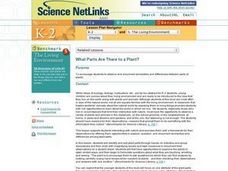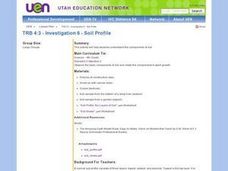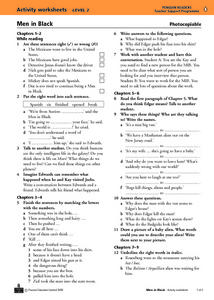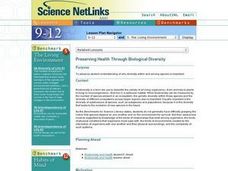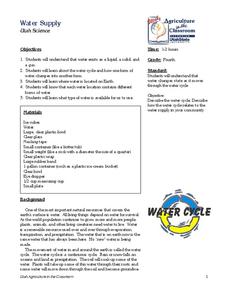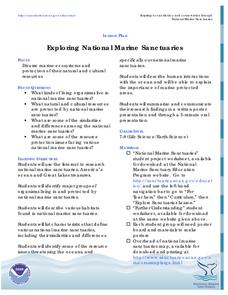Curated OER
What Parts Are There to a Plant?
Students identify and sort plant parts through hands-on activities and group discussions and then work with magnifying lenses and tape measures to document their observations on a student sheet.
Curated OER
Soil Recipe
Students examine the components of soil. They work together to use different materials to create their own soil. They make their own dirt cake as well.
Alabama Learning Exchange
Observation of Yeast Growth
Middle schoolers build an apparatus to look at how yeast cells grow by converting food to energy. They observe yeast both with and without food and see how yeast produces carbon dioxide.
Curated OER
DNA Extraction
Students extract and observe a visible amount of DNA from Escherichia. coli cells. They discuss the properties of DNA. Confirmation of the presence of DNA by a reaction with an indicator is confirmed within this instructional activity....
Curated OER
Investigation 6 - Soil Profile
Fourth graders study the components of soil. They observe the basic components of soil and relate the components to plant growth. They record color, texture, and kinds of materials on their profile log (light color, denser, grittier -...
Curated OER
Food Chains and Food Webs
In this biology worksheet, students read about food chains and food webs. They then answer 4 questions regarding the information they just learned. The answers are on the last page in the packet.
Curated OER
Soil
In this soil worksheet, students read about soil and the attributes that determine how soil is formed. They then answer the 11 questions in the packet. The answers are on the last page of the packet.
Curated OER
Men in Black: Activity Worksheets
In this set of activity worksheets for the story, Men In Black, students complete a total of 23 questions: short answer, word order, matching and true/false. Worksheets are followed by a 9 question assessment.
Curated OER
Taking Apart Owl Pellets
Students dissect an owl pellet. In this rodent and bone structure lesson, students work in groups to take apart an owl pellet. Students separate all the tiny bones from the fur and use the bones to reconstruct the rodent on a tag board....
Curated OER
What is Cacao?
Students use the Internet to learn about the cacao plant. In this plants lesson, students complete a KWL chart on chocolate, learn about cocoa plants and discuss the parts of a plant. Students use the Internet to learn how the cacao...
Nemours KidsHealth
Germs: Grades K-2
Students demonstrate knowledge about germs. For this health lesson, students investigate what germs are, how to protect the skin by comparing the skin to apple skins, and the proper hand washing technique for getting rid of germs....
Curated OER
Garden of Eden
Students view a video clip about animals and their habitats. They work together to discuss how different animals adapt to their environments. They create a new habitat for a specific animal and draw new adaptations for them.
Curated OER
Plant and Animal Cells - Are they Different?
High schoolers observe the similarities and differences between plant and animal cells. In this cell activity, students use microscopes to observe self prepared slides of animal and plant cells.
Curated OER
Preserving Health Through Biological Diversity
Young scholars research and explore the benefits of biodiversity, particularly as it relates to human health. They write an essay in which they explain the possible effect of human activities on the emergence of new diseases.
Curated OER
Reasons for Seasons
Students model the tilt of the Earth as it orbits the Sun. They explain the meaning and characteristics of solstices and equinoxes. They explain that sunlight hits the Earth at different angles at different locations over the course of...
Curated OER
Classify the Microbes
Students classify microorganisms into categories based on their characteristics. Pupils use a taxonomic key to identify organisms. They classify certain bacteria, protists, and viruses using a classification or taxonmic key.
Curated OER
From Eggs to Frogs
Third graders receive a small container of tapioca pudding, they are to pretend that it is frog eggs. The students pretend they are birds who see the eggs, and eat some of them. They discuss what would happen if these were really frog...
Curated OER
Web of Predators and Prey
Students investigate the food chain by researching the Internet. In this ecosystem activity, students view the video "Competitor and Predator" and read a book from the series "The Magic School Bus." Students utilize a worksheet to...
Curated OER
Web of Life - Role-Playing
Students role-play how organisms adapt to their environment. They play 20 questions with plant and animal habitats. They create a web of life to demonstrate how each plant and animal relies on the other for survival.
Curated OER
Water Supply
Fourth graders complete three activities. In this water supply lesson, 4th graders learn that water can exist in different forms and watch a demonstration of each form. Students explore the water cycle and make a water cycle using the...
Curated OER
Exploring National Marine Sanctuaries
Students research marine ecosystems by creating class presentations. In this oceanography lesson, students research the different locations of marine sanctuaries by identifying them on a transparency map in class. Students create...
Curated OER
This Land Is Our Land
Students explore land use. In this land lesson, students examine the use of land and land records. They create a diagram of a specified piece of land and determine the area of the land. Students discuss their findings.
Curated OER
Weather, Climate and Atmospheric Process
Students explore Earth science by completing a could identification activity. In this weather lesson, students discuss the different forms of measurement for the weather of Earth. Students discuss global warming and examine a list of...
Curated OER
Creating a Classification System
Students create classification system for Arctic-dwelling animals, the Arctic hare in particular.


